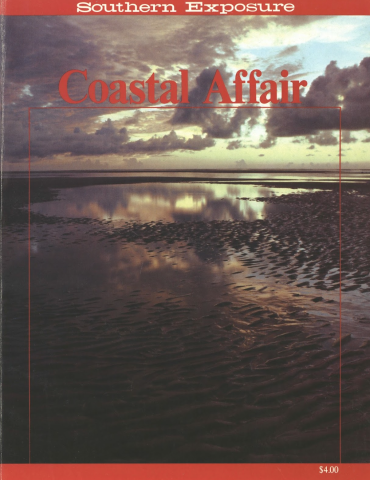
This article originally appeared in Southern Exposure Vol. 10 No. 3, "Coastal Affair." Find more from that issue here.
There was a time when all swamps were dismal and every parking lot meant progress. Attitudes have changed, though, and people have begun to realize the real value of swamps, bogs, marshes and tidal flats — our nation’s wetlands.
An estimated 40 percent of the continental United States’ wetlands have already been surrendered to row crops, housing and marina developments, waste dumps, parking lots, power plants and other human enterprises. Those remaining that are not specifically protected continue to be ditched, drained and filled. Such losses are of special concern to Southern states with nearly 90 percent of the Lower 48’s coastal wetlands, according to U.S. Fish and Wildlife Service estimates.
Louisiana’s deltaic marshes, Florida’s mangrove swamps and North Carolina’s peat bogs are all periodically saturated with water and therefore come under the broad “wetlands” classification, along with salt marshes and meadows, pocosins, tidal flats, open freshwater expanses and fens. Biologically speaking, wetlands are among the most productive of natural systems — they teem with fish, wildlife, hardy vegetation and tiny organisms that flourish off the abundant plant life, muds and shallow, sun-warmed waters.
Today we know that wetlands perform biological functions essential to coastal ecologies as well as to the larger life-sustaining environment. In fact, wetlands are economic assets, and here are a few of the services they provide — for free.
Filters: The abundant plant life and decomposers in wetlands systems tend to absorb incoming water impurities. When water leaves the wetlands it is always cleaner than when it arrived. Within limits, this natural filtration system can take up various pollutants — such as waste water from sewage treatment plants and runoff from agricultural fields and residential developments — and use them as nutrients. Scientists have concluded that an acre of estuarine marsh does about $14,000 worth of work each year in purifying treated sewage.
Flood buffers: By sponging up excess water, wetlands act as natural breakwaters during storms and rainy seasons. Even in fierce hurricanes, coastal developments protected by extensive marshes suffer comparatively little flooding damage.
Fresh water suppliers: When dry weather comes, wetlands slowly release their reservoir of water, and this purifying, sponging, slow-release system recharges underground aquifers. Draining wetlands for large-scale agricultural and housing developments in Florida has contributed to groundwater shortages there. Such shortages affect more than wells; they are vital to plant life, and scientists believe they are closely linked to climatic conditions as well.
Food source: Wetlands are the base of a vast food chain, creating organic material that feeds the plants and fish and other animals which feed on each other, some of which we eat. Georgia salt marshes produce 10 tons of organic material per acre per year, ecologist Eugene Odum found. Much of this nourishment washes out into nearby waters; over half the organic matter in a typical Gulf Coast estuary (where salt water freely mixes with fresh water flowing out of the marshes) is the result of wetlands productivity.
Although the economic and ecologic importance of wetlands is undeniable, few people find it profitable to own one in an undisturbed condition. Yet it is clear that the larger public cannot afford to lose these natural systems.
For further reading: Our Nation's Wetlands, a federal interagency task force report coordinated by the now-defunct Council on Environmental Quality, 1978. For sale for $5.00 from: Superintendent of Documents, U.S. Government Printing Office, Washington, DC 20402. Stock No. 041-011-00045-9.

